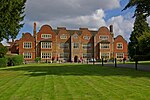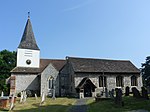Ranmore Common SSSI
Sites of Special Scientific Interest in Surrey

Ranmore Common SSSI is a 224.3-hectare (554-acre) biological Site of Special Scientific Interest in Ranmore Common, north-west of Dorking in Surrey.This site is mainly woodland, some of it ancient, but there are also areas of heath and rough pasture. The dominant trees are pedunculate and sessile oaks, with a shrub layer of holly, silver birch and yew. There is a diverse community of breeding birds and invertebrates include the satin wave moth and the white admiral butterfly.
Excerpt from the Wikipedia article Ranmore Common SSSI (License: CC BY-SA 3.0, Authors, Images).Ranmore Common SSSI
Ranmore Common Road, Mole Valley
Geographical coordinates (GPS) Address Nearby Places Show on map
Geographical coordinates (GPS)
| Latitude | Longitude |
|---|---|
| N 51.247 ° | E -0.364 ° |
Address
Ranmore Common
Ranmore Common Road
RH5 6SR Mole Valley
England, United Kingdom
Open on Google Maps









